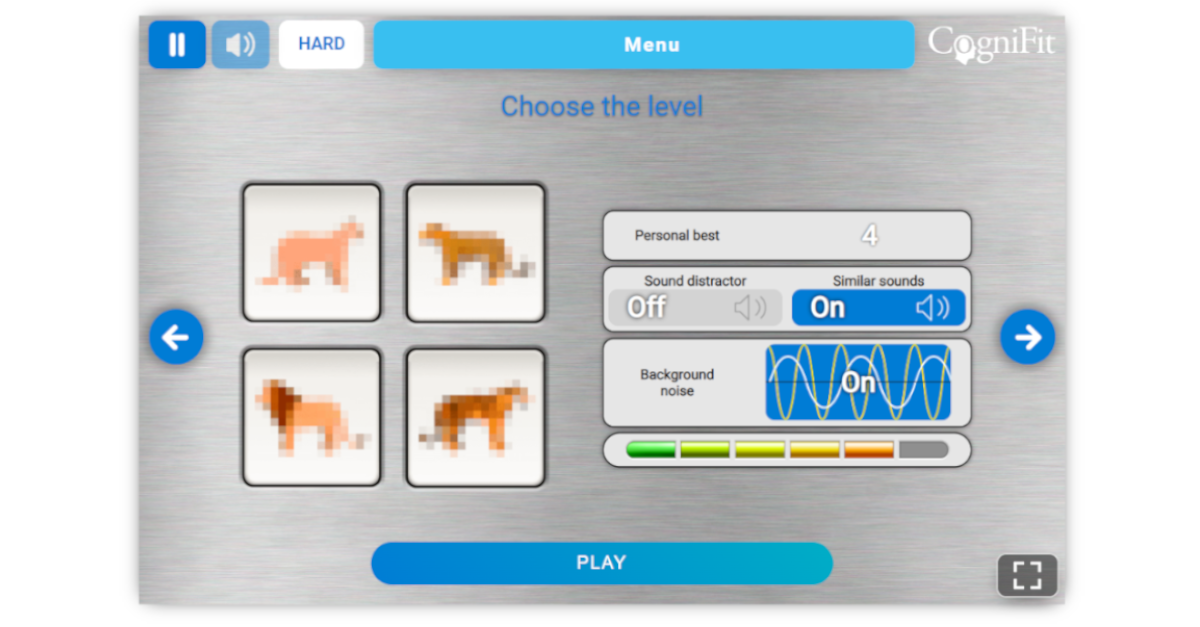
Scrambled Game – Work Your Perception & Attention Abilities
Something like listening to your favorite music or picking up the phone and recognizing someone’s voice might seem like a simple thing. Maybe even reading a book or glancing at a text from a friend. But what goes on between your eye, ears, and brain might only take seconds but is impressively complicated.
CogniFit’s game “Scrambled” was made to target three specific brain functions: Auditory perception, Focused Attention, and Visual Perception. And, in this article, we will look at each of these processes, what can happen if they are impaired, and how this game works at different levels to help you strengthen these areas.
How Does The Game Work?

At easier levels, Scrambled might seem like a breeze. But don’t let this game fool you.
After you’re asked to do a simple audio test (Aka. “Can you hear this tone coming out of your computer?”) you’ll be prompted to choose a level. Even if you’re confident in your cognitive abilities, it’s recommended to start at a beginner’s level. This is for one very important reason, which we’ll look at later.
The basis of Scrambled is simple.
You’ll hear a sound recording. After it ends, click on the image the sound comes from. For example, if the sound is a blender, you would click on the picture of a blender. You keep listening and clicking until you get one wrong, and then the game is over. After, you’ll be prompted to choose which level to start at again. But don’t worry. The sounds are randomized so it’s okay to do the previous level over again!
But what happens at harder levels?

Well, there is a combination of four obstacles thrown at you:
- Background noises
- Similar sounds
- Sound Distractors
- Distorted images
For example, at the hardest levels, the images will be highly pixilated and you’ll have a bombardment of competing sounds. All of this is to make you concentrate both visually and auditorily. Some images will really trip you up – like a picture of a flute versus an oboe which are hard to tell the difference between when they’re really blurred. This is why (as mentioned earlier) it might be better to start at earlier levels so you can at least get an idea of the pictures that are used.
So, with all these sounds and images, how does the Scambed Game help your cognitive functions?
Let’s take a closer look.
Scrambled Game & Auditory Perception
It’s been well documented that “exercising” your brain functions (neural network) can create new ones. Therefore making them “stronger.” Auditory Perception is no exception. This is why you’ll hear various, competing sounds during the game.. But what is this ability exactly?
Well, in plain terms, it’s our brain’s ability to interpret the different information we get from the environment through our ears. Audio waves zip through the air and reach the inner ear. Then, certain cells are activated and transmit signals through nuclei until they reach the medial geniculate nucleus (in the thalamus).
After that, it goes to the auditory cortex in the temporal lobes, Finally, the information is sent to other parts of the brain so it can do its thing. During this entire process, we are deciphering the tone, timber, duration, and intensity of what we are hearing.
Some areas where auditory perception is vital are in a classroom environment, driving safety, and musical abilities.
But what happens when this perception is damaged or altered in a negative way?
- General deafness
- Wernicke’s aphasia (inability to understand language)
- Amusia (inability to recognize music)
- Tinnitus (constant ringing in the inner ear)
- Musical hallucinations (hearing music that isn’t there)
Scrambled Game & Focused Attention
Also called “Sustained Attention”, this brain function allows someone to pay attention to something for a long time. However, it can also be divided into two subcategories. The first is vigilance (detecting the appearance of a stimulus) and the second is concentration (focusing on the stimulus or activity).
There are also sub-components:
- Arousal: activation level and level of alertness, whether we are tired or energized.
- Focalized Attention: to focus attention on a stimulus.
- Sustained Attention: to attend to a stimulus or activity over a long period of time.
- Selective Attention: to attend to a specific stimulus or activity in the presence of other distracting stimuli.
- Alternating Attention: to change focus attention between two or more stimuli.
- Divided Attention: to attend to different stimuli or attention at the same time.
You’ve probably heard of problems with focused attention in the form of ADD or ADHD as well as dementia or dyslexia.
The Scrambled game forces you to flex your attention muscles by making you focus on images and sounds within competing stimuli.
Scrambled Game & Visual Perception
This brain function might be the easiest one for most people to understand. Light rays reach our pupils then go to the receptor cells in the retina. They are then processed in our brains where we can distinguish things like size, shape, color, light, contrast, position, etc.
Two prime examples of where Visual Perception is key is while someone is driving or anyone who is interested in creating art, designs, or crafts.
Having the images linked to the sounds in CogniFit’s Scrambled game is one way this visual brain function is exercised – especially at higher levels where the images are highly pixilated.
Scrambled Conclusion
If you’re new to brain games, Scrambled is one of the easier ones to ease you into your weekly exercise regiment. Also, everyone can benefit from the Sustained Attention aspect. However, don’t forget there is a slew of other brain games on the CogniFit site. So, don’t forget to check them out!













